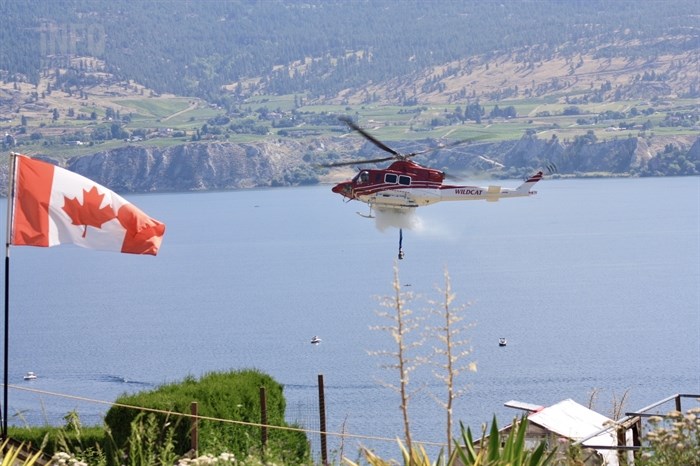
A helicopter refills its water tank in Okanagan Lake during the fight against a grass fire in Sage Mesa just north of Penticton, Thursday, Aug. 6, 2020.
(STEVE ARSTAD / iNFOnews.ca)
July 03, 2021 - 1:28 PM
With fires raging around the B.C., officials are encouraging people to be prepared for the worst.
That means being prepared to stay at home with an emergency kit or to leave immediately with a grab-and-go bag. Gather and organize emergency supplies now so they're ready when disaster strikes.
The province offered up this guideline and reminded people to consider the unique needs of a household, such as including items for pets or seniors.

Grab and go bags are essential this time of year.
Image Credit: SUBMITTED/Province of B.C.
Build a Grab-and-go Bag
Be ready to go by having a smaller version of your emergency kit (as seen below) in an easy-to-access place in your home. In addition to having one at home, create grab-and-go bags for your workplace and vehicles that contain:
-
Food (ready to eat) and water
-
Phone charger and battery bank
-
Small battery-powered or hand-crank radio
-
Battery-powered or hand-crank flashlight
-
Extra batteries
-
Small first-aid kit and personal medications
-
Personal toiletries and items, such as an extra pair of glasses or contact lenses
-
Copy of your emergency plan, copies of important documents, such as insurance papers
-
Cash in small bills
-
Local map with your family meeting place identified
-
Seasonal clothing and an emergency blanket
-
Pen and notepad
-
Whistle
Emergency kit supplies
Put your supplies in one or two containers, such as plastic bins or duffel bags. Store them in an area of your home that’s easy to get to, such as a hall closet, spare room or garage.
-
Non-perishable food: three-day to one-week supply, with a manual can opener
-
Water: four litres per person, per day for drinking and sanitation
-
Phone charger, battery bank or inverter
-
Battery-powered or hand-crank radio
-
Battery-powered or hand-crank flashlight
-
Extra batteries
-
First-aid kit and medications
-
Personal toiletries and items, such as an extra pair of glasses or contact lenses
-
Copy of your emergency plan, copies of important documents, such as insurance papers
-
Cash in small bills
-
Garbage bags and moist towelettes for personal sanitation
-
Seasonal clothing, sturdy footwear and emergency blanket
-
Dust masks if you live in an area that's prone to earthquakes
-
Whistle
-
Help/OK Sign: Display the appropriate side outward in your window during a disaster.
To contact a reporter for this story, email Kathy Michaels or call 250-718-0428 or email the editor. You can also submit photos, videos or news tips to the newsroom and be entered to win a monthly prize draw.
We welcome your comments and opinions on our stories but play nice. We won't censor or delete comments unless they contain off-topic statements or links, unnecessary vulgarity, false facts, spam or obviously fake profiles. If you have any concerns about what you see in comments, email the editor in the link above.
News from © iNFOnews, 2021